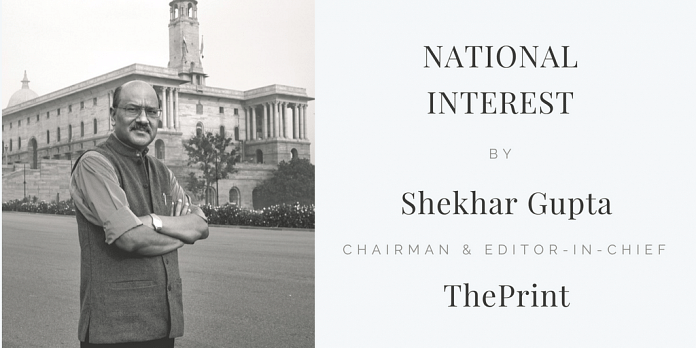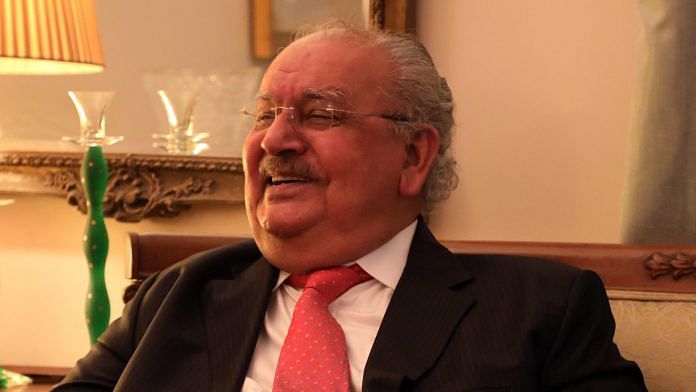Naresh Chandra (1934-2017) wasn’t an ordinary patriot. A big-hearted problem-solver, he had the trust of 9 prime ministers.
The description we use most lazily – and safely – in a tribute to a prominent public figure on his passing away, is “patriot”. Lazy, because any fellow Indian must be presumed to be a patriot. And safe, because nobody is likely to question you. We are too polite to speak ill of the dead.
The equation changes when the person is somebody who was more than once insinuated to be a traitor, a foreign “mole”. That too by powerful and influential people. It changes also because the man was most certainly among the greatest patriots two generations of Indian strategists have seen, through the tenure of nine prime ministers.
 Naresh Chandra never used his last name “Saxena”, perhaps to give anonymity to older brother Girish “Garry” Saxena who joined RAW, became its legendary chief, and passed away recently (14 April). But anybody who knew him, would accept that he was not just another IAS officer civil servant who rose to hold every job a serving officer would covet: Chief Secretary of Rajasthan, Water Resources Secretary, Defence, Home and then the bureaucratic Mount Kailash, Cabinet Secretary. There wasn’t a box in the service hierarchy Nareshji left unchecked.
Naresh Chandra never used his last name “Saxena”, perhaps to give anonymity to older brother Girish “Garry” Saxena who joined RAW, became its legendary chief, and passed away recently (14 April). But anybody who knew him, would accept that he was not just another IAS officer civil servant who rose to hold every job a serving officer would covet: Chief Secretary of Rajasthan, Water Resources Secretary, Defence, Home and then the bureaucratic Mount Kailash, Cabinet Secretary. There wasn’t a box in the service hierarchy Nareshji left unchecked.
He was one of a kind. In so many decades of interacting with smart people, I am not sure I have met two more with approach to a new challenge, or a crisis. He sparkled in problem-solving, flourished in a crisis. Better still, he was the greatest teller of stories. Never in a manner of boasting. In fact, he would tell these as if these were just funny interludes but often explained how he employed some learning from his district service to resolve what looked intractable. He didn’t tell you all the facts.
BE IT New Delhi or New York, I am no early riser. So it is never welcome when the phone rings at 6 am, as it did at Manhattan’s Lexington Hotel (then an Indian hangout as it was owned by the Taj Group) in the fall of 1997 while the UN General Assembly was on. Naresh Chandra, then India’s ambassador to Washington, was calling, distraught. “Arrey bhai, yeh kya chhap diya aap ne?” he asked me in his characteristic Allahabad Hindustani. “Main to yahan safeer hoon, aur yeh keh rahey hain ki main spy hoon.” (What have you published? I am the ambassador here and this gentleman says I am a spy.) In a few hours he had to accompany Gujral to the meeting with President Bill Clinton.
He was referring, of course, to an article written by Swadeshi Jagran Manch convener and my friend, S. Gurumurthy, in The New Indian Express. The article delved into the mystery of Narasimha Rao planning a nuclear test, getting the site ready in Pokharan and then pulling back at the last moment, as the Clinton administration confronted him with satellite and intelligence evidence of his plans. Gurumurthy’s suggestion was that the US had been tipped off by a mole, and that was Naresh Chandra. The ambassador said he was coming to see me in the Lexington lobby with a faxed copy of the article.
I tried explaining to him the complexities of the Indian Express group, that The New Indian Express was, in fact, another newspaper owned by another branch of the same family and therefore this particular article had not been published in the paper I edited. But Chandra’s point simply was, that is all very well but hum ab duniya bhar ko kya munh dikhayenge (what face do I have for the rest of the world)?
I obviously was of no great help. I knew his credentials — as well as his connections. In any case, as cabinet Secretary, he would have known every secret worth keeping — RAW, incidentally, is controlled by the Cabinet Secretariat. At the same time you couldn’t dismiss Gurumurthy out of hand. He has access, intellect, and you can argue with his views on all things, from economics to foreign policy to definition of secularism, but you can’t question his patriotism. So what the hell was the truth?
I searched for an answer obsessively for more than a decade, raising it with Gujral, Vajpayee and Narasimha Rao. All I got were enigmatic smiles with things like, “ab isko chhodiye aap” (now you forget this). But in the topmost establishment nobody believed the slur on Chandra. Rao had appointed him his interlocutor for the negotiations with the US on nuclear and missile issues. Gujral and then the BJP which followed continued to have him as ambassador to Washington in spite of the fact that the startling allegation — of espionage, no less — had been made by none else than Gurumurthy, who had so much clout with the top echelons of the RSS and BJP and open access to both the Vajpayee and Advani households.
And to complete that intriguing circle, in 2006, we saw sitting on the dais with other distinguished speakers at Jaswant Singh’s book release, Naresh Chandra himself, telling delightful stories of how, as India’s ambassador to a bitter, betrayed Washington in the May of 1998, he got by telling no lies, as diplomats proudly say they do for their country, but speaking as Jack Nicholson told Diane Keaton in Something’s Gotta Give, “some version of the truth”. Jaswant Singh claimed in his book that there was a mole in Rao’s circle. If he had the vaguest suspicion that Chandra was that spy/traitor/mole, why would he have him sharing the stage with him?
EACH TIME I harassed Narasimha Rao on this, he merely patted his belly as if to say, let it be there. In a ‘Walk The Talk’ interview, when I pressed on December 1995, he shut me up by saying, “leave at least something for me to take to my chita (funeral pyre).” Jaswant Singh’s 2006 book gave me fresh impetus to resume that search. The result was a series of three ‘National Interest’ columns (‘Mountain in the Molehill’, ‘How We Built the Bomb’, and ‘The Mole and the Fox’). The “mole” was Chandra, and the fox, Rao. But my conclusion in those articles, which hasn’t been challenged since (including by him) was that Rao had never meant to test. He was under pressure from the Clinton administration to roll back his nuclear plans at a time when India was vulnerable.
The fox played a subterfuge on the Americans by pretending to test, getting caught and then “cancelling” to give Clinton comfort and buy Indian scientists the time they needed. Naresh Chandra was probably a player in this, a willing “mole”, but all for a good, patriotic cause. It is just that his reward later was these insinuations of high treason. The fact is, it was on 18 March 1989 that Rajiv Gandhi took him aside at an IAF firepower demonstration at Tilpat, outside Delhi, said Pakistan was “a screwdriver’s turn away from its nukes” and India should start active weaponisation. He gave the keys to Chandra who guarded our strategic equivalent of the family silver directly for a decade, until Pokharan-2. Footnote: a few months later, Centre conferred the Padma Vibhushan on him and that ended all whispers.
Chandra’s patriotic commitment was so stubborn, it didn’t shake even when it was viciously questioned. He won’t even write a memoir, not so much to come clean but to tell the country some of what he did. What people would like to read, I can’t write. What I can write, nobody would read, he would say. He was, quite simply among the finest servants of Mother India we have seen in our times.




S. RAGHOTHAM writes in response to ‘National Interest: Keeper of India’s Family Silver’ – By Shekhar Gupta, published on 14 July 2017
Shekhar Gupta, as usual, writes from his inside knowledge, but he gets a small detail wrong. Gurumurthy’s article could not have been in 1997, and if it was, it couldn’t have been in The New Indian Express (TNIE), because in 1997, Indian Express was still an undivided national paper with 21 editions. The split, of course, may have been in the works, but TNIE started to appear in mid- or late-1999. I myself left the undivided IE on April 28, 1999. So, Gurumurthy’s article must be later.
Also, while he largely gets Naresh Chandra right, I think the surmise about the Fox and the Mole playing subterfuge with the US on the 1995 N-test is a bit of a stretch. But, perhaps SG knows better. I did my own “investigation” into Jaswant Singh’s “mole” affair and came to a different conclusion about who it could have been. Here’s my 2006 piece: Jaswant’s mole story: connect the dots http://bit.ly/2tX1W0N (although I don’t reveal my mind there). SG asks if Jaswant Singh would have shared the stage with Naresh Chandra at a book launch if he had known or thought him to be the mole, but Jaswant Singh did more than that — Naresh Chandra was present in almost all of the Singh-Talbott meetings.
But ‘Keeper of India’s family silver’ is very apt for Naresh Chandra at another level, although I don’t know if SG meant it that way. What struck me when I visited NC’s otherwise modest house in Vasant Kunj was that everything in that place, except the man himself and the namkeens and chai he offered, was silver, mostly antique silver. Someone later told me that NC belonged to a family that had been in civil service not for one or two generations but almost in an unbroken line from the time of the Khilji dynasty – that’s about 1,000 years! I don’t know if that was true, but it all does add up – all that silver as well as the kind of trust NC commanded, as SG says, from nine PMs.
I have a different story to tell about Naresh Chandra, but I am still thinking whether I should or not. Because, as SG says, “He didn’t tell you all the facts”, but on one occasion, he did tell me enough (in just one line) about what was then still a sensitive subject.
SHEKHAR GUPTA responds:
We shared content with TNIE then but had no control over what it published. Guru article appeared before we had formally split
S. RAGHOTHAM:
Ok, I suppose we are both right then – it was Sonthalia-Gurumurthy IE that you didn’t control, but it still appeared as IE, not TNIE. Anyway, that was a minor point.
those ere the days of rao and abv true patriots. we are noe in sgs days
Very interesting story. Diplomacy works in mysterious ways and it was wonderful to read how India got the better of mighty spy agencies and scored a diplomatic victory. A handover from a congress government to a bjp government of time to prepare for pokharan 2. Kahaan gaye wo log? These days they don’t even wish each other if they cross paths.